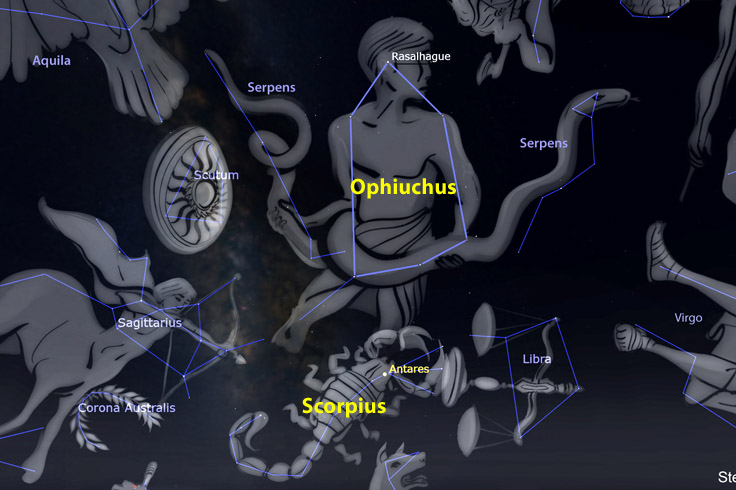Count on our monthly Sky Tour podcast to help you get the most out your casual stargazing. It’s a fun and informative way to introduce yourself to the nighttime sky!

Listen Here:
Podcast: Play in new window | Download
Subscribe: Apple Podcasts | Google Podcasts | Spotify | Email | RSS | More
True darkness is fleeting in summertime, especially at higher latitudes. At more southerly latitudes you get a bit more nighttime, but not much. So let’s make the most of the darkness we have — and it'll be that much easier using our monthly Sky Tour astronomy podcast!
Perhaps more than in any other constellation, the stars of Scorpius really do look like their namesake. Antares is the scorpion’s heart. To its upper right and lower left are two medium-bright stars representing its body. Less than one fist to Antares’ upper right is a vertical row of three stars marking the head. To their right, are the stars of Libra, which in ancient times were perceived as the critter’s claws. Trailing from Antares to the lower left is a string of stars that arc down and then turn upward, ending in a close-spaced pair of stars at the stinger end.

Stellarium
There’s one more constellation of note in this area. It’s a big one — 11th in size among all 88 modern constellations. And yet perhaps you’ve probably never heard of it. Ophiuchus, which in ancient Greek meant “the serpent holder,” is in plain sight every dark, clear evening this month (though none of its stars are particularly bright). Now, you’re not going to recognize some guy holding snakes among the stars. But don’t worry: By listening to this month’s Sky Tour podcast, you’ll learn what Ophiuchus has to do with a rocket ship’s nose cone!
Earth’s two closest planetary neighbors are low in the west after sunset this month. Start looking almost as soon as sundown. Look to the left of the sunset point for Venus. This planet is quite bright, but its dazzle is diminished somewhat due to the twilight around it. Wait until twilight deepens, and you’ll find Mars just a few degrees to the upper left of Venus. But you’ll have to work harder to see it — Venus is hundreds of times brighter.
Later this month two surprise guests will join the stage just above the western horizon, but you’ll have to listen to this month’s podcast to learn their identities!
In fact, our monthly podcast is a fun and informative way to learn all kinds of interesting tidbits about the night sky. So why not give this month’s Sky Tour podcast a listen? Download or stream this month’s episode using the links above, then head outdoors to enjoy what the night sky has to offer.
 0
0
Comments
You must be logged in to post a comment.